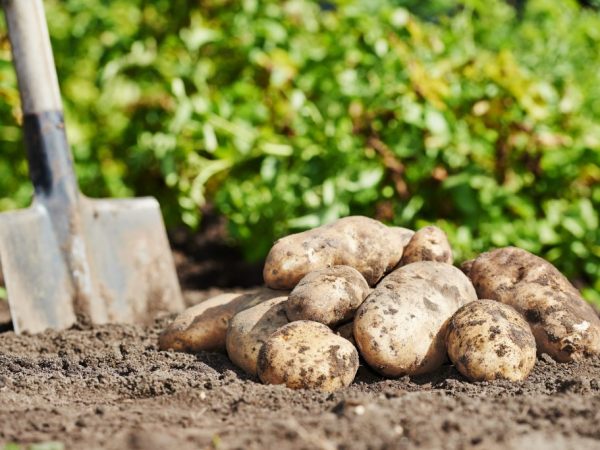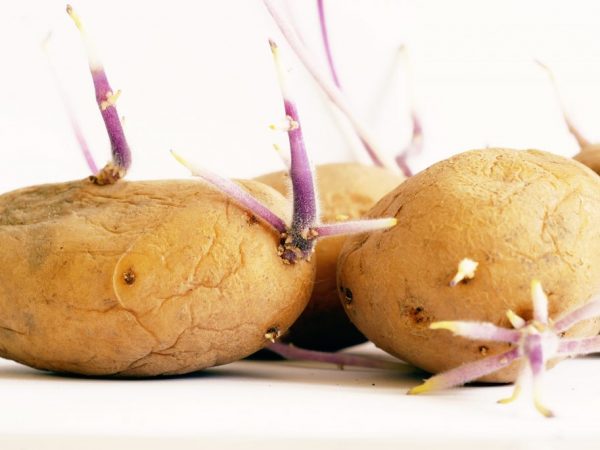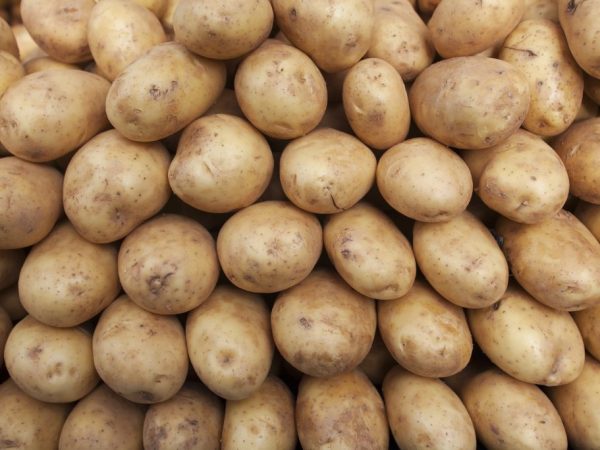Potato variety breeze
According to gardeners, potatoes breeze is no worse than similar foreign species, so it is worth considering all the features of this variety in order to familiarize yourself with it in detail. In 2005, in the Republic of Belarus, breeders of the Scientific Center of Academic Sciences, who are studying potato growing, developed a new variety, and also patented it and gave it the name breeze.

Potato variety breeze
After this discovery, a year passed and such a variety was successfully entered into the register of the Republic of Belarus, and then into the Russian catalog of vegetables in 2009. The breeze was recommended for planting in the northern and western parts of Russia, as these tubers are resistant to various climatic conditions and common diseases. Before buying this variety, it is recommended to study the characteristics and read the potato breeze description of the variety, reviews from other gardeners who have already grown such a variety on their site.
Description of potato breeze
According to gardeners, the breeze potato variety has an erect bush of medium height. The stem is slightly thinner than other varieties and does not have a bright shade. The leaves are large, bright green. Inflorescence in the form of a corolla, reddish or purple, medium in diameter. The breeze has a large yield percentage, which reaches up to 600 centners per hectare.
For this variety, this is a pretty good indicator. In the description of the potato variety breeze, it is indicated that the tubers are oval, large, with a yellow and smooth peel, covered with a small number of small eyes. The weight of one fruit is about 130 grams. The inner flesh is yellow, which does not disappear even during cooking. The starch content in one tuber is 12-16%. Breeze is widely used in cooking and is mainly used fried to make chips, fries or freezes.
Pros of the breeze variety
- Good keeping quality.
- Excellent taste of the fruit.
- Beautiful tuber shape.
- Stable immunity to viral diseases such as mosaic and fungus.
Variety yield
The largest harvest was recorded in the Kaliningrad region, when agricultural farmers harvested 450 centners per hectare, this figure is more than that of other similar varieties. By standards, about 300 centners of tubers are harvested per hectare. In the Republic of Belarus, a harvest of 625 centners per hectare was registered. All this is due to the high plasticity and adaptability to nutritional value, air permeability and water permeability of the soil on which the plantings grow. The experts concluded that the more you improve the nutrient composition of the soil, the greater your yield will be.
The breeze is an early variety and during the growing period it was recorded that already on the 35th day of planting, they reached a yield of 60 centners per hectare.After 1.5 months, this figure was already 170 centners per hectare, and almost 2 months later - 270 centners per hectare. It should be noted that this variety has one feature. According to its positive qualities, this variety is especially popular among gardeners for the sale of precisely young tubers. Due to its taste, smooth skin and oval tubers, the breeze variety is in great demand.
Preparation of planting material

Tubers need to be prepared for planting
- For two weeks, the tubers are kept in the light at a temperature of 13 degrees. For hardening two days before planting, the tubers must be covered with bags. If there is, then you can even use hay or straw or any material for insulation. You can check the temperature of the soil using a thermometer, placing it 10 cm deep. Plus soil temperature should be about 8 degrees.
- You should also add potash and superphosphate fertilizers to the soil, and then dig up the soil for planting. The holes are dug according to the scheme: depth - 10 cm, the distance between the holes - 40 cm, between the grooves - 70 cm.This scheme provides free passage, and during flowering and growth dense thickets do not form, which also affects the nutrition of the plant and its yield.
- We put the tubers in the holes with the sprouted eyes upwards, and fill them with nutritious soil with the addition of ash on top. This method protects the plant from pests and a number of diseases.
Rules for planting and growing varieties of breeze
For planting, it is necessary that the earth warms up to a temperature of 7-8 degrees, with a depth of 10-12 cm, only in this case you can begin to plant the planting material in the ground. Typically, the planting period begins in season by early May. Despite the fact that the general characteristic for such potatoes is positive, it is not recommended to plant planting material before May so that the plantings do not freeze. As for the nutritional value of the soil, the breeze is successfully grown throughout Russia. If you ensure timely watering of the plantings, then you can count on a high yield on any soil.
Planting is recommended according to the following scheme: at the rate of 550 tubers per one hundred square meters of land with light soil, up to 400 tubers for heavy soil. In order for the harvest to be plentiful and of high quality, and the taste of the fruit to be the best, you should properly care for the plantings.
The breeze grows well in beds that are abundantly and constantly watered. The taste and resistance to disease are directly affected by the amount of watering of the plantings. This variety does not tolerate both arid and overly moist soil equally badly. This variety accepts mineral fertilizers well. It accepts superphosphate and ammonium sulfate well, as it is necessary to maintain the pH of the soil. In this way, the breeze receives nutrients for its further and productive development.
Potato breeze propagation
The breeze successfully propagates vegetatively with the help of tuberous parts divided into halves, seedlings during germination, branches, as well as dividing the bush and tuber seeds. With the vegetative method of reproduction, you can get more harvest, but it is worth considering that after 4-5 years of constant planting of potatoes, its yield decreases and the taste deteriorates. This is often due to the fact that planting material should be replaced with new tubers, since the old ones lose their effectiveness, and thus yield decreases.
The description indicates that for a constant and good harvest, you need to change the planting material for a new one, periodically replacing the seed tubers. When planting seeds, a year later, only small fruits are harvested, and when they are planted next year, good tubers grow. The good thing about the breeze is that it is not susceptible to mechanical damage, due to its long keeping quality.The characteristic of the variety is such that the tubers do not require special conditions during storage, and a dry basement is suitable for such a variety, where the temperature ranges from 2 to 5 degrees.
How to store potato breeze properly?

Store potatoes in a cool place
More than 97% of gardeners believe that this variety is suitable for winter storage and at the same time the tubers do not lose their presentation. It is often necessary to observe such varieties, and especially early ones, which simply do not reach the spring and are subject to rot, spoilage and early germination. Vegetable growers who sell early, young potatoes are beginning to look for varieties needed for planting. Also, gardeners take care of the condition of the basements and storage facilities for the potato crop.
Potato breeze differs from many varieties in that when the tuber warms up, the germination of shoots begins. Therefore, experienced gardeners do not store tubers in very warm rooms. Tubers can also germinate in bright light. Thanks to the light, the buds become denser, leveled and the seedlings sprout more actively. Vegetable growers do not cover the tubers in order to keep the fruits in good condition. The presentation of the breeze tubers is very good and is equal to the percentage of 95-96%, which is considered an excellent indicator.
Diseases and pests
The cultivar is susceptible to potato nematode. If this parasite lives in your garden, then you should look for another cultivar to grow or get rid of the pest. There is also a small chance of scab damage. The breeze is moderately resistant to the black stem. There is a possibility of being affected by a fungal infection, but this is only with a weakened immunity of the variety. If the immunity of the planting is weakened, then it is recommended to carry out fungicidal treatments. At the moment, agrochemists have a large selection of quality drugs.
Using them in a timely manner, such drugs can stop the appearance of the fungus, and when it appears, prevent the spread of infection throughout the field. Also, when selecting any type of potato, the varieties are often compared with those already planted in the garden and, as experience shows, it is not worth drawing conclusions for one season. For two or three years, based on your experience, correctly assess all the features and disadvantages of this variety. In this way, you can choose the potato variety that is right for your region and will give a good harvest.
Late blight treatment
Late blight is the most insidious of all nightshade diseases. The focus of infection is the disease-causing fungus. If fungal diseases are detected, it is recommended to treat the plantings with fungicides. And in no case should sick tubers be prepared for planting. In this case, as a preventive measure, regular weeding is needed. If not treated promptly, the disease can kill about 71% of the crop due to affected areas. At the same time, the seed material loses its immunity, and the eyes completely disappear.
Scab treatment
Against the scab, the treatment of tubers with fungicides is used, fertilization is applied in order to create the effect of a slight acid reaction in the soil. As mentioned during the ripening period, weakened tubers are often prone to infection. In the future, for prevention and control, seed material must be properly prepared for planting, first of all, it is necessary to rinse the tubers, destroy the affected areas. For processing, drugs such as heterosis, urea are suitable. Planting corn on the potato planting site can also help with this problem. This is how you can protect plantings and secure the soil in advance. Also, do not forget to process and feed the soil with minerals.
Reviews of the potato variety breeze
According to gardeners, if you are looking for the best and newer varieties, then it is worth stopping your choice on this particular potato. The external and taste qualities of the fruit are winning more and more lovers of this variety every year.Vegetable growers have been planting this potato for several years, and they argue that the more fertile the soil, the higher the indicators, and there are fewer small potatoes. However, many who trade potatoes on the market are not happy, since not all people want to buy exactly large potatoes, since they often contain voids inside, and this leads to rapid spoilage and rot of the tuber. After passing the tasting, the variety was rated by gardeners and experts at 7 points, which is quite a good indicator and received a mark as "good".
Everyone, without exception, likes the taste of the fruit. Gardeners and summer residents are, in principle, satisfied with this variety, but they argue that outwardly the variety is the same as everything else, it is precisely in the taste and abundant yield. Also, potatoes are not boiled during cooking. Gardeners claim that if you use additional fertilizer to the soil, the taste of the potatoes will be much tastier. Potatoes are rich in nutrients thanks to the well-fertilized soil, and during processing they restore their mineral and organic balance of substances every year.


